Euroluce 2023: Hélène Binet’s show at the fair casts new light on iconic architecture and more
For a new exhibition at Euroluce 2023 (18-23 April), Hélène Binet revisits some of her most iconic architectural shots, and experiments with nature in a new photographic series

Hélène Binet is best known as a photographer of architecture, but she could also be described as a philosopher of light. A new exhibition at Euroluce during Salone del Mobile 2023 (18-23 April) celebrates the return of the world’s largest fair dedicated to the design of natural and artificial light. It is the chance to see photographs from Binet’s remarkable career, as well as a series of new images that mark a turn towards a freer and more playful way of working with light.
Since the 1980s, Binet has captured some of the most iconic images of architecture. Imposing strict limits on her approach by working in black and white, and only using analogue techniques, her images heightened the drama and power of buildings that defined the late 20th century. Her career developed in parallel to that of clients and collaborators such as Zaha Hadid, Peter Zumthor and Daniel Libeskind. Over time, she has formed relationships of mutual respect with the many leading architects who have turned to her to interpret their work.
‘Hélène Binet: Nature, Time and Architecture' at Euroluce 2023

Echoes and Reveries, to Gottfried Böhm’s Centenary (2020)
‘Hélène Binet: Nature, Time and Architecture’ is curated and designed by architect Massimo Curzi and will be shown as part of the cultural programme of Euroluce, the multidisciplinary lighting fair that runs alongside Salone del Mobile. It promises to be visually stunning: from the outside, a purpose-built gallery will appear as a pristine box covered with brushed aluminium, while inside, Binet’s dramatic photographs, many of them hand-printed, will be hung on a soft background of midnight blue felt, creating a muffled acoustic environment. As visitors walk into the space, the first work to appear will be a large new print featuring a building by Peter Zumthor. ‘It will be like a beam of light as you enter,’ explains Binet.
Salone del Mobile president Maria Porro describes the exhibition as a perfect expression of the aim of Euroluce, ‘to be a place for dialogue between technology and poetry, architecture and design, and light and art’. The show will provide ‘a moment of suspended time’, an opportunity for pause and reflection within the busy fair.
Hélène Binet's life in photography and architecture

Peter Zumthor, Therme Vals, Switzerland (2006)
Returning to Italy and showing her work here for the first time is an emotional moment for Binet, who has lived in London for more than 30 years: ‘I grew up in Rome, but Milan is where I became an adult,’ she says, reflecting on a period of 18 months when she worked as a photographer’s assistant in the mid 1980s. In 1986, the impact of seeing an early installation by Libeskind, The House Without Walls, at the Milan Triennale, set her mind racing with the possibilities of architecture as a subject for photography.

The Walls of Suzhou Garden, China (2018)
Later that year, Binet moved to London to be with her partner, the architect Raoul Bunschoten, who was teaching at the Architectural Association (AA). Under the inspirational directorship of Alvin Boyarsky, the AA was the most exciting school of architecture in the world, with graduates and visiting lecturers including Hadid, Libeskind and John Hejduk. Spotting Binet’s potential, Boyarsky dispatched her to international locations to photograph buildings for the books he planned to publish. The photographs she took during this period set in motion her exploration of architecture and light. But whether Binet has been photographing one or the other is not always clear, a dilemma famously expressed by Louis Kahn: ‘Architecture appears for the first time when the sunlight hits a wall. The sunlight did not know what it was before it hit a wall.’

Peter Zumthor, Kolumba Diocesan Museum, Germany (2007)
One of Binet’s first trips was to Athens to photograph the pathway designed by Dimitris Pikionis at the Acropolis in the 1950s. Producing a series of characteristic black-and-white square format images, Binet captured reflections of light, patterns and textures on the recycled stones that implied the traffic of people through the ages. Three of these works were shown as very large prints (1.2m x 1.2m) at Binet’s recent exhibition at the Royal Academy of Arts in London, and are echoed in a more recent series taken at Lunuganga, the country house of architect Geoffrey Bawa in Sri Lanka. Exhibited at Euroluce for the first time, the prints depict routes around Lunuganga, with steps and pathways alluding to the presence of Bawa, who died in 2003, having refined the design for 50 years.
Wallpaper* Newsletter
Receive our daily digest of inspiration, escapism and design stories from around the world direct to your inbox.
Binet rarely includes people in her photographs, but their spiritual and poetic presence is always strong. This effect perhaps comes from the depiction of light, which she says is a constant reminder of humanity’s need to navigate the world in both a philosophical and practical sense. In her depictions of the Jantar Mantar observatory in Jaipur, India, from 2002, light and shadow are used as instruments for spiritual guidance.


A new set of images, shown in Milan for the first time, following the passing of time through the life and death of a flower
Light, Binet observes, has the capacity to tell us where we are in the world and in life. Her photographs of Le Corbusier’s Couvent Sainte-Marie de La Tourette have a dramatic rhythm, measuring time as if it were a musical score through the movement of shadows across a stone floor. Whereas in more recent images shot in Korea, the light is gentle, reflecting Binet’s view of nature there as a ‘motherly presence’, protecting buildings.
‘In my career, I’ve had a lot of discipline, but now I’m interested in following my instincts,’ says Binet. A new set of four images, being shown in Milan for the first time, follow the passing of time through the life and death of a flower. Using a macro lens, and natural light filtered through frosted glass, the images were taken in the space of one hour. Whether they are a complete break from her past work is not yet clear. ‘Hadid’s and Sergio Musmeci’s structures are seen as artificial, but they mimic the action of nature. So I think the distinction between architecture and nature is ultimately artificial,’ says Binet. Her new work is about fragility, movement and energy, but these are also increasingly the themes of architecture and design.
‘Hélène Binet: Nature, Time and Architecture’ will be on show from 18-23 April at Euroluce, Hall 11
helenebinet.com
salonemilano.it
A version of this story appears in the May 2023 issue of Wallpaper*, available now in print, on the Wallpaper* app on Apple iOS, and to subscribers of Apple News +. Subscribe to Wallpaper* today

The Walls of Suzhou Gardens, China (2018)

Lunuganga Estate, Bentota, Sri Lanka, 1998

Le Corbusier’s Couvent Sainte Marie de La Tourette, France, part of The Secret of the Shadow (2002)
Vicky Richardson is Head of Architecture and Drue Heinz Curator at the Royal Academy of Arts, London. She curated the exhibition Light Lines: The Architectural Photographs of Hélène Binet at the RA in 2021.
-
 Rug designer Sibylle de Tavernost’s homage to Fernard Léger
Rug designer Sibylle de Tavernost’s homage to Fernard LégerAbstract modern art, craft heritage and contemporary life fuse in Sibylle de Tavernost's new limited-edition rugs
By Harriet Thorpe Published
-
 Private gallery Stiftung Froehlich in Stuttgart stands out with an organic, cloud-shaped top
Private gallery Stiftung Froehlich in Stuttgart stands out with an organic, cloud-shaped topBlue-sky thinking elevates Stiftung Froehlich, a purpose-built gallery for the Froehlich Foundation’s art collection near Stuttgart by Gabriele Glöckler
By Hili Perlson Published
-
 RIBA House of the Year 2024: browse the shortlist and pick your favourite
RIBA House of the Year 2024: browse the shortlist and pick your favouriteThe RIBA House of the Year 2024 shortlist is out, celebrating homes across the UK: it's time to place your bets. Which will win the top gong?
By Ellie Stathaki Published
-
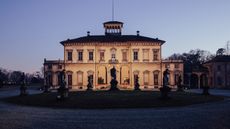 Design showcase Alcova announces its 2025 locations in Milan
Design showcase Alcova announces its 2025 locations in MilanAlcova, the roving design exhibition, will expand its footprint with two new locations in the northern Milan suburb of Varedo – a former factory and ancient greenhouses
By Laura May Todd Published
-
 Elevate your interiors with Wallpaper* July 2024, the Design Directory
Elevate your interiors with Wallpaper* July 2024, the Design DirectoryWallpaper* July 2024 rounds up the best new furniture, lighting, kitchens, bathrooms and more – on sale now
By Bill Prince Published
-
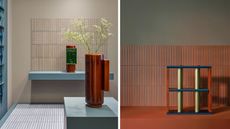 Casa Mutina displays Ronan Bouroullec's creative universe
Casa Mutina displays Ronan Bouroullec's creative universeRonan Bouroullec's designs for Mutina at Milan Design Week 2024 include outdoor tiles as well as ceramic editions
By Cristina Kiran Piotti Published
-
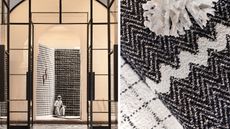 Jaipur Rugs unveils collaboration with Chanel's yarn maker Vimar1991
Jaipur Rugs unveils collaboration with Chanel's yarn maker Vimar1991During Milan Design Week 2024, Jaipur Rugs demonstrated its expertise through a collaboration with Chanel-owned yarn experts Vimar1991
By Cristina Kiran Piotti Published
-
 Wallpaper* and SNOW explore the alchemy of grown diamonds in a new film
Wallpaper* and SNOW explore the alchemy of grown diamonds in a new filmWallpaper* and grown-diamond specialist SNOW partnered on the Class of ’24 exhibition during Milan Design Week 2024 and a new film exploring the art and alchemy of the laboratory’s process
By Simon Mills Published
-
 Adal brings Japan's disappearing natural materials to furniture design
Adal brings Japan's disappearing natural materials to furniture designJapanese brand Adal Look into Nature exhibited for the first time at Salone del Mobile 2024, showcasing its contemporary products made using igusa, a traditional material whose manufacturing is slowly disappearing
By Danielle Demetriou Published
-
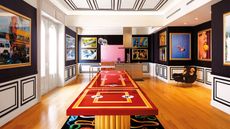 Toiletpaper Apartment debuts in Milan with a 'sophisticated' Alex Prager collaboration
Toiletpaper Apartment debuts in Milan with a 'sophisticated' Alex Prager collaborationToiletpaper present 'ToiletAlex PaperPrager' their new unsettling projects on the occasion of Milan Design Week 2024
By Cristina Kiran Piotti Published
-
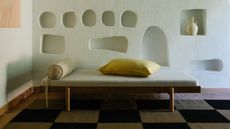 Japan in Milan: the best of Japanese design at Milan Design Week 2024
Japan in Milan: the best of Japanese design at Milan Design Week 2024Discover the best of Japanese design showcasing innovative designs from terrazzo tables to tree-inspired textiles at Milan Design Week and Salone del Mobile 2024
By Danielle Demetriou Published